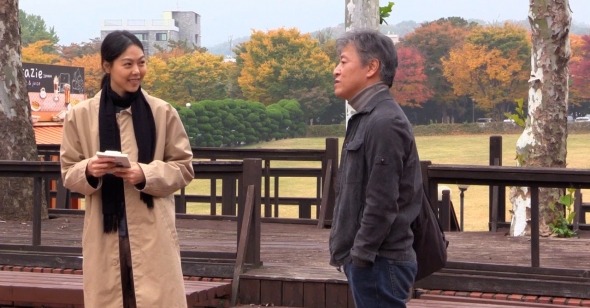Act Natural
By Shonni Enelow
By the Stream
Dir. Hong Sang-soo, South Korea, Cinema Guild
Jeonim (Kim Min-hee) watercolors alone by an urban waterway in the opening of Hong Sang-soo’s delicate By the Stream. Set in a women’s college of art and design in Seoul, the film begins as Jeonim, a no-longer-so-young junior professor, has brought her formerly famous uncle, Chu Sieon (Kwon Hae-Hyo), to direct a skit in the college’s theater festival. The stream itself is not emphasized in those first shots, just a bit of the mundane cityscape, but over the course of the film it quietly transforms as we see it in different settings, especially as the backdrop to the restaurant where Sieon and Jeonim go with Jeonim’s colleague, Jeong (Cho Yun-hee), a rapt fan of Sieon’s with whom he bonds over the film’s many scenes of eating and drinking. We see it again at the very end of the film very differently, a tear of nature in the midst of the city, rough and uncontrolled.
By the Stream joins a spate of recent international films about theater––more specifically, about the people who make theater (Drive My Car and Janet Planet come to mind). In all three, theater appears embedded in irreducibly local contexts; watching theater in these films is a way of seeing a place as much as the individual people in it. In By the Stream, we don’t see much of the struggle to make the play––one scene in which Sieon blocks the young actors around a table is all. We also only see one short section of the skit, marked as such by theatrical lighting and its historical content: the life of women during war, the political tenor of which leads to the play’s soft censorship by the college audience and (unseen) censure of the professors by the university president (surely Hong intended the metatextual resonances of his casting of Kwon Hae-hyo, a longtime activist for left-wing causes, as Sieon). In By the Stream, the framing conventions of theater are not a way of delineating––or blurring––the distinction between artificiality and truth, or of delimiting an arena of emotionality against which the neutral film performances read as subtle and authentic. In fact, what’s striking about the acting in the skit is how subtly the amateur students perform the realist dialogue, how unforced their performances are, how naturally they carry out the everyday scene.
The making of the play provides the dramatic scaffolding for the unfolding of life, but both the skit and the college life that surrounds it are presented as spontaneous, oblique, and devastating in their elisions. But it’s also telling that the theater performance is the only time Hong uses an obvious lighting scheme and the first time we hear a soundtrack (except for opening credits), which returns in two of Hong’s concluding images. In the first of these, on her way to the president’s office where she will clearly be reprimanded (and possibly more), Jeonim waves an enormous leaf that has fallen from a tree; in the film’s final shot, she balances on rocks as she walks towards us. The film’s final line––she tells them that around the bend of the stream she saw “nothing, nothing at all,” delivered by Kim Min-hee with piercing lucidity, makes plain both its interest in theater and the relation between that interest and its striking cinematic gestures. Like all of Hong’s recent films––in which many of the same actors repeatedly perform, as a kind of repertory company––this is a film about actors, and about the form of art that only actors can do: the charging of “nothing” with the intensity of what is humanly inexpressible, and yet humanly expressed.
“Chekhovian” has become a stock term to describe almost anything that feels small, sad, and realist, but after Hamaguchi’s staging of Uncle Vanya in Drive My Car, it feels more possible to think through what the legacy of Chekhov’s specific form of realism is and why it recurs so often in film. The answer, not surprisingly, is acting. Russian realist acting (viz. Stanislavksi) took shape with and through Chekhov’s plays, and it’s hard to imagine the genres of realist acting without Chekhov. The reason is Chekhov’s unparalleled use of subtext, which Hong also prizes, and frames, in By the Stream, when Sieon tells the students that he wants them to perform as if every gesture, tone, and intonation had more weight than the words themselves. Hong’s films, like Chekhov’s plays, are made up of intimate, everyday scenes infused with unstated depths of failure, despair, and loneliness, often staged around a meal, where the business of eating and drinking gives the actors a foundation for the more complex business of relating to each other. They drink, they laugh, they cry, they sit in silence awkwardly. Over the course of his long-take scenes, resonances and meanings accrue: Jeonim’s gratitude, we learn, was hard won; Sieon’s regrets are less professional than personal. The actors unspool their characters’ interiors softly, reaching the final meal together, where we do at last learn a bit more about the tensions and uncertainties we’ve sensed, with an unhurried rhythm of slight remove.
Though Hong’s matter-of-fact cinematography—when he needs a close-up, he doesn’t change the camera position, he zooms in—adds to the feeling of unlabored intimacy, art as labor is, in fact, one of the film’s themes, in another substantive echo of Chekhov. Jeonim, like Uncle Vanya’s Sonia (another not-so-young woman who finds her ideals tarnished), finds the value of her life in work: it’s work that gives her life meaning, work that organizes her days and nights. She is a textile artist, and we finally see her work in her studio late in the film, as Jeonim shows her uncle a piece inspired by the river. The texture, she tells him, is always different from what she plans. It’s an apt metaphor for Hong’s film, in which watching actors becomes a way to experience the making of art as ongoing labor––unadorned, but never simple.
